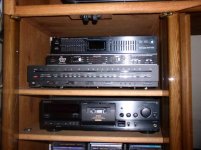Hi Quasi,
I'd say the poobah is very well insulated.
Now that we are all waxing nostalgic ..... Gimme another beer friends, just make sure your high school years were not the best years of your life. That would be so sad.
As far as the higher end stuff is concerned, Ill agree provided we are talking about the real high end equipment. Not that pseudo poorly designed garbage.
-Chris
I'd say the poobah is very well insulated.
Now that we are all waxing nostalgic ..... Gimme another beer friends, just make sure your high school years were not the best years of your life. That would be so sad.

As far as the higher end stuff is concerned, Ill agree provided we are talking about the real high end equipment. Not that pseudo poorly designed garbage.
-Chris

Wookie, you look after the power cord guys in the south, I'll take care of those north of the border and west of the Rockies. I been looking to start a club. Then we won't have to do the dirty deeds ourselves. But you're right, it "feels good"
...And everyday, the paperboy brings more.
...And everyday, the paperboy brings more.
while we're on the subject of beer...can i recommend my favourite pilsener? brewed in downtown toronto.
An externally hosted image should be here but it was not working when we last tested it.
latala said:Early one had a 709 ext compensation op amp
regards trev
Thanks latala. Did Crown drop that afterwards? The schematics for the 75 (I think) are at work and I can't recall the PS details. It used something like a 10 watt or so resistor to drop supply voltage to the one side of the chip and the heat eventually lifted traces and fried the board.
edit: A car wash would be a good start on that puppy!
TomWaits said:Oops! Attention Moderator on duty, we need a new thread called DC300A RESTORATION & MODS
New thread here http://www.diyaudio.com/forums/showthread.php?s=&threadid=86650

NAK 730 receiver(s)
I've been rebuilding/restoring these since my first one purchased used back in '84...
still using one to drive my DIY rd75 line source arrays... and the sound is still awesome, even with the original power cord...
I've got 3 working and one for spare parts... the torroidal main xfrmr is massive... only thing quirky with these receivers is the "touch" contols' sensitivity to humidity... but a good cleaning of the sensors seems to fix that... main problem is re-bulbing the indicator lights... a pain until you get the hang of dis-assembly...
back in 1990 I took one of them to a local high end MacIntosh clinic..."Spectral Fidelity Test Clinic" where they were running comparison tests with Macs to show how crappy your equip was and how superior Macs were...
When they tested the Nak, the THD + IM spec measured 0.007 % across the audio band to ~ 14Khz and .025% @ 20Khz (both channels driven to 105 watts each. Not that I gave a $#%^ about the specs, but the Mac folks were pi&*ed because it beat their equipment and anything else (of the 75 odd amps they'd tested that day)
These things still sing, and when they do break (if ever) they'll make great boat anchors 'cause they weigh a TON. I've blown the amp boards on 2 of them in the past by accidentally shorting the speaker leads at full power (OOPS!) but they're pretty easy to fix. You should have seen the arc/spark! l Not to mention the sound and smell
Not to mention the sound and smell
So, IMHO, the late seventies sound is just fine with me, afa amps go, but with speakers, we've come a long way.
I've been rebuilding/restoring these since my first one purchased used back in '84...
still using one to drive my DIY rd75 line source arrays... and the sound is still awesome, even with the original power cord...

I've got 3 working and one for spare parts... the torroidal main xfrmr is massive... only thing quirky with these receivers is the "touch" contols' sensitivity to humidity... but a good cleaning of the sensors seems to fix that... main problem is re-bulbing the indicator lights... a pain until you get the hang of dis-assembly...
back in 1990 I took one of them to a local high end MacIntosh clinic..."Spectral Fidelity Test Clinic" where they were running comparison tests with Macs to show how crappy your equip was and how superior Macs were...
When they tested the Nak, the THD + IM spec measured 0.007 % across the audio band to ~ 14Khz and .025% @ 20Khz (both channels driven to 105 watts each. Not that I gave a $#%^ about the specs, but the Mac folks were pi&*ed because it beat their equipment and anything else (of the 75 odd amps they'd tested that day)
These things still sing, and when they do break (if ever) they'll make great boat anchors 'cause they weigh a TON. I've blown the amp boards on 2 of them in the past by accidentally shorting the speaker leads at full power (OOPS!) but they're pretty easy to fix. You should have seen the arc/spark! l
So, IMHO, the late seventies sound is just fine with me, afa amps go, but with speakers, we've come a long way.
Attachments
I regularly blow away studio owners with my system. ALL rebuilt 70s equipment; Hafler, Phase Linear, Soundcraftsmen, Realistic, Pioneer. In fact, the only component that's less than 37 years old is my CD player. I restored all of this equipment and I've got to tell you, I have yet to audition a system costing less than 25K that comes close to outperforming it. Oh, and that's with 35 year old Radio Shack "Lifetime Guaranteed" interconnects and 10 gauge outdoor extension cord wire for the speakers. I'm happy with my system, and I'm hoping you all are as happy with yours. Cheers!
VintageDave, since you've seen fit to resurrect this 6 year old thread, causing me to read the whole thing (ack!?), my 2c worth:
In 40 years the basic components for a linear, discrete solid state power amplifier haven't improved much. In fact, as it was pointed out, many great parts have fallen into obsolescence. While parts and the circuits may not have changed too much, however, a lot of progress has been made in simulation, testing, and measurement so while the overall design might be similar, the level of refinement is surely not. Finally, that's a lot of time to learn from past mistakes. Multi-hundred watt power amplifier with no overcurrent protection? No thanks!
Electrolytics notwithstanding, there is no reason that a great sounding amp from the 70s cant still sound great today, but for all the fuss and bother vis. reliability and safety there little reason to actively go and seek it out unless you enjoy repairing stuff. Easier and cheaper in the long run, I would think, to build your own or buy a much more recent component, say late 80s, early 90's vintage.
In 40 years the basic components for a linear, discrete solid state power amplifier haven't improved much. In fact, as it was pointed out, many great parts have fallen into obsolescence. While parts and the circuits may not have changed too much, however, a lot of progress has been made in simulation, testing, and measurement so while the overall design might be similar, the level of refinement is surely not. Finally, that's a lot of time to learn from past mistakes. Multi-hundred watt power amplifier with no overcurrent protection? No thanks!
Electrolytics notwithstanding, there is no reason that a great sounding amp from the 70s cant still sound great today, but for all the fuss and bother vis. reliability and safety there little reason to actively go and seek it out unless you enjoy repairing stuff. Easier and cheaper in the long run, I would think, to build your own or buy a much more recent component, say late 80s, early 90's vintage.
Last edited:
- Status
- This old topic is closed. If you want to reopen this topic, contact a moderator using the "Report Post" button.
- Home
- Amplifiers
- Solid State
- The sonic merits of late '70s SS amps


